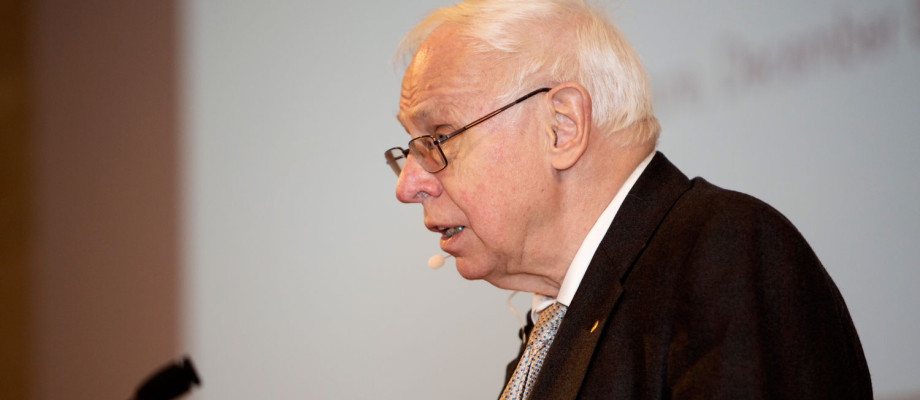NOBEL. DNA is fragile, but also has an innate ability to repair itself, explained Nobel Prize winner Tomas Lindahl in a lecture on Monday, arranged by the University of Gothenburg and Chalmers University of Technology.
“Water in particular is harmful to living tissue, something that William Shakespeare was aware of.”
University of Gothenburg Vice-Chancellor Pam Fredman and Chalmers First Vice President Mats Viberg welcomed Tomas Lindahl when he held the lecture in the Wallenberg Hall at the Wallenberg Conference Center on December 14. The topic was The Intrinsic Fragility of DNA.
 He began by telling how he noticed that the RNA molecule was broken down by heat as early as the 1960s when he was a post doc at Princeton University. This gave him the idea that DNA might not be particularly stable either, which was a somewhat odd notion at the time.
He began by telling how he noticed that the RNA molecule was broken down by heat as early as the 1960s when he was a post doc at Princeton University. This gave him the idea that DNA might not be particularly stable either, which was a somewhat odd notion at the time.
“When I came home to Sweden, my meticulous assistant Barbro Nyberg and I began to conduct time consuming studies of the stability of DNA at various temperatures, pH values and ion strengths. I arrived at the surprising conclusion that thousands of potential damages occur to DNA every day.
These results should lead to living organisms dying very quickly. But since we actually keep living, often for many years, there must be something in the organism that repairs the damage.”
Tomas Lindahl discovered a mechanism called base excision that eliminates damage arising from water and oxygen, among others. The family of enzymes that are involved in the repair process is called DNA glycosylases. Among others, there is an enzyme that eliminates uracil, which is in RNA but should not be in DNA, something the enzyme needs to do hundreds of times a day in every cell of the body.
“There are many molecules that can damage DNA and all of them have probably not been identified yet. But the fact that water can be dangerous to living tissues was already known by Shakespeare. In Hamlet for instance, the gravedigger notes that ‘water is a sore decayer of your wretched dead body,’ which is also true of DNA.”
But Tomas Lindahl is not alone in having received a prestigious award. In the afternoon, the winners of the Save the Egg competition were also recognized.
“The competition is based on building a vehicle that makes it possible to drop a egg from a height of 15 meters without breaking it. This year, nearly 1,700 fifth graders took part and three winners were chosen,” explained project manager Per-Anders Träff of Chalmers.
The best technical solution was from Önnerödsskolan, the most esthetic solution came from Böskolan and the best presentation was made by Fiskebäcksskolan. Three representatives from each class got to go up on stage and receive awards handed out by Nobel Prize winner Tomas Lindahl.
Facts
In connection with the Nobel Prize ceremony on December 10, the University of Gothenburg and Chalmers University of Technology have a tradition of inviting one or more Nobel Prize winners to hold a lecture for students and anyone else who is interested. This year, it was the winner of the Nobel Prize in chemistry, Tomas Lindahl, who held the lecture entitled The Intrinsic Fragility of DNA in the packed Wallenberg Hall of the Wallenberg Conference Center at the University of Gothenburg.
TEXT: EVA LUNDGREN
PHOTO: JOHAN WINGBORG












